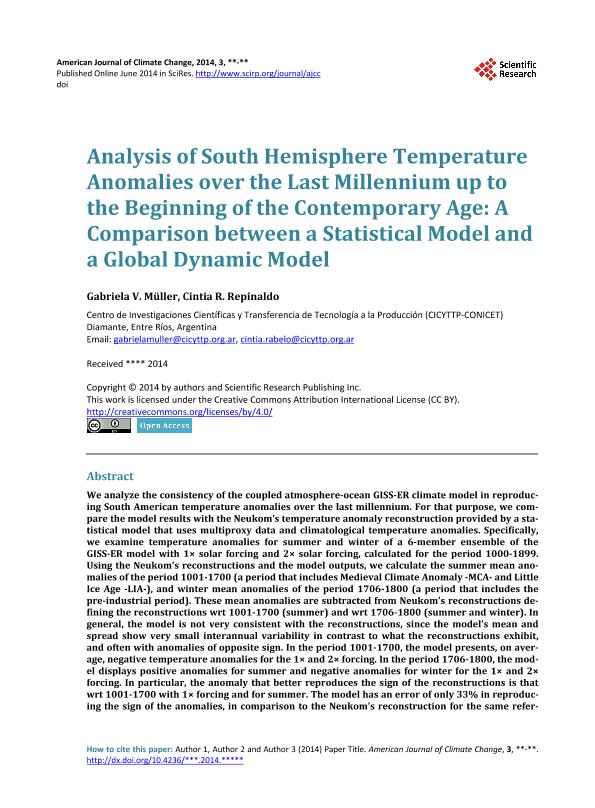Artículo
Analysis of south hemisphere temperature anomalies over the last millennium up to the beginning of the contemporary age: a comparison between a statistical model and a global dynamic model
Fecha de publicación:
06/2014
Editorial:
Scientific Research
Revista:
American Journal of Climate Change
ISSN:
2167-9495
e-ISSN:
2167-9509
Idioma:
Inglés
Tipo de recurso:
Artículo publicado
Clasificación temática:
Resumen
We analyze the consistency of the coupled atmosphere-ocean GISS-ER climate model in reproducing South American temperature anomalies over the last millennium. For that purpose, we compare the model results with the Neukom’s temperature anomaly reconstruction provided by a statistical model that uses multiproxy data and climatological temperature anomalies. Specifically, we examine temperature anomalies for summer and winter of a 6-member ensemble of the GISS-ER model with 1× solar forcing and 2× solar forcing, calculated for the period 1000-1899. Using the Neukom’s reconstructions and the model outputs, we calculate the summer mean anomalies of the period 1001-1700 (a period that includes Medieval Climate Anomaly -MCA- and Little Ice Age -LIA-), and winter mean anomalies of the period 1706-1800 (a period that includes the pre-industrial period). These mean anomalies are subtracted from Neukom’s reconstructions defining the reconstructions wrt 1001-1700 (summer) and wrt 1706-1800 (summer and winter). In general, the model is not very consistent with the reconstructions, since the model’s mean and spread show very small interannual variability in contrast to what the reconstructions exhibit, and often with anomalies of opposite sign. In the period 1001-1700, the model presents, on average, negative temperature anomalies for the 1× and 2× forcing. In the period 1706-1800, the model displays positive anomalies for summer and negative anomalies for winter for the 1× and 2× forcing. In particular, the anomaly that better reproduces the sign of the reconstructions is that wrt 1001-1700 with 1× forcing and for summer. The model has an error of only 33% in reproducing the sign of the anomalies, in comparison to the Neukom’s reconstruction for the same reference period. The model’s anomaly wrt 1001-1700 with 1× forcing for summer also reproduces the MCA and LIA’s sign of the reconstruction. The MCA’s sign is reproduced in almost 75% of the comparisons, and the LIA’s sign in more than 73% of the comparisons with the reconstruction, indicating that the model can represent this important anomalies.
Palabras clave:
Temperature Reconstruction
,
Climate Models
,
Solar Forcing
,
Mca
,
Lia
Archivos asociados
Licencia
Identificadores
Colecciones
Articulos(CICYTTP)
Articulos de CENTRO DE INV.CIENT.Y TRANSFERENCIA TEC A LA PROD
Articulos de CENTRO DE INV.CIENT.Y TRANSFERENCIA TEC A LA PROD
Citación
Muller, Gabriela Viviana; Rabelo Da Rocha Repinaldo, Cintia; Analysis of south hemisphere temperature anomalies over the last millennium up to the beginning of the contemporary age: a comparison between a statistical model and a global dynamic model; Scientific Research; American Journal of Climate Change; 3; 2; 6-2014; 205-211
Compartir
Altmétricas




